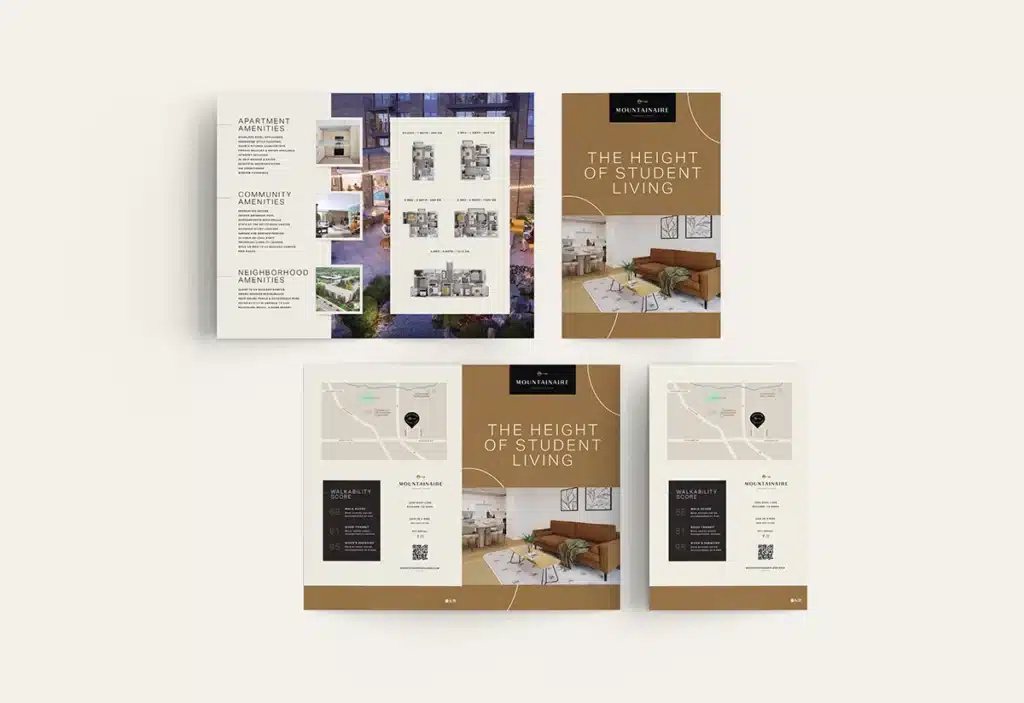The real estate market is packed, especially when it comes to apartments in good areas. With so many options available, renters have plenty to choose from, which makes it harder for multifamily property management companies to stand out. A solid marketing plan isn’t just a nice-to-have—it’s the key to keeping units filled, attracting great residents, and staying competitive.
Gone are the days when simply listing an apartment and waiting for inquiries was enough. Today’s renters are doing their research, comparing options online, and looking for more than just a place to live. They want convenience, community, and amenities that fit their lifestyle. That means creating a marketing plan for apartments requires more than just a “For Rent” sign—it takes a mix of digital strategies, local outreach, and creative engagement to grab attention and turn interest into signed leases.
This guide breaks down what it takes to successfully market an apartment, from understanding your ideal renters to using online platforms, video tours, and promotions to drive interest. By the end, you’ll have a clear, practical plan to make your property stand out in a crowded market. Let’s get started.

Understanding Your Target Market
Before diving into marketing tactics, it’s important to know who you’re trying to attract. The more you understand your ideal renter, the easier it is to tailor your messaging, pricing, and advertising efforts to reach the right audience.
Identifying the Ideal Renter
Different properties within your community may appeal to different residents. Some renters prioritize affordability, while others are looking for luxury amenities. Consider factors like:
- Demographics – Age, income level, family status, and employment type.
- Lifestyle Preferences – Do they want a pet-friendly apartment? A social atmosphere? Quiet and private?
- Location-Based Needs – Proximity to work, schools, nightlife, or public transport.
- Budget Considerations – Are you targeting high-income professionals, students, or middle-class families?
Market Research & Competitive Analysis
Understanding the broader rental market and your direct competitors can help fine-tune your marketing approach. Some key steps include:
- Check local rental trends – What’s the average rent for similar apartments in your area? Are prices rising or falling?
- Analyze competitor properties – Look at their websites, social media, and listings. What amenities and incentives are they offering?
- Survey current residents – Ask what attracted them to your apartment and what could be improved.
- Use online research tools :
- Google Trends – See search demand for apartments in your city.
- Zillow & Apartments.com – Analyze pricing, availability, and reviews.
- Social media insights – Monitor local rental groups and community discussions.
By combining demographic insights with real-world data, you can craft a marketing strategy that speaks directly to the renters who are most likely to sign a lease.
Crafting a Unique Selling Proposition (USP)
Now that you’ve narrowed down your target market, you can start figuring out how to tailor your strategy to them. Renters have options, so why should they choose your apartment community over another? This is where a unique selling proposition (USP) comes in.
Your USP is what makes your property stand out. It’s the core message that tells potential residents why your property is the best fit for their needs.
Defining Your USP
Think about what sets your property apart. It could be:
- Location – Is it in a prime spot near schools, businesses, or nightlife?
- Amenities – Do you offer a fitness center, smart home features, or pet-friendly spaces?
- Pricing & Value – Are you more affordable than similar apartments in the area? Do you offer flexible lease terms?
- Community & Lifestyle – Do you host resident events or have a strong sense of community?
The key is to highlight what matters most to your ideal renters. If you’re targeting young professionals, emphasize modern interiors, coworking spaces, and high-speed internet. If families are your focus, showcase spacious layouts, parks, and nearby schools.
Creating a Strong Message
Once you’ve identified your USP, craft a clear, compelling message that can be used across your website, ads, and listings. A strong USP should be:
- Concise – Keep it short and impactful.
- Benefit-Driven – Focus on what renters gain.
- Memorable – Make it stand out from competitors.
For example:
- “Luxury living in the heart of downtown—walk to work, shops, and nightlife.”
- “Pet-friendly apartments with spacious layouts and a private dog park.”
- “Affordable student housing just steps from campus—fully furnished and all utilities included.”
By defining and consistently using your USP, you create a strong, recognizable brand for your apartment community—one that speaks directly to the needs and desires of your ideal renters.
Digital Marketing Strategies for Market Apartment Plan

A strong online presence is essential for marketing apartments. Renters aren’t just driving around looking for “For Rent” signs anymore—they’re searching online, reading reviews, and comparing options before they even schedule a tour. A solid digital marketing strategy ensures your apartment community is easy to find and appealing to potential residents.
Website & SEO
Your website is the first impression many renters will have of your property. A well-designed site should be:
- Easy to navigate – Include clear menus for floor plans, pricing, and contact info.
- Mobile-friendly – Many renters browse on their phones, so your site needs to be responsive.
- Fast-loading – Slow websites turn people away before they even see your listings.
- Visually appealing – High-quality photos and virtual tours are a must.
In addition to design, SEO (Search Engine Optimization) helps your site rank higher in Google searches, making it easier for renters to find you. Some key SEO strategies include:
- Using relevant keywords – Terms like “apartments for rent in [city]” should appear in your website content.
- Optimizing your Google My Business profile – This helps your property show up in local searches and maps.
- Adding a blog – Regularly posting content about moving tips, neighborhood guides, or apartment living can improve your search rankings.
Social Media Marketing
Social media platforms are one of the best ways to engage with potential renters, show off your property, and build a sense of community. The most effective platforms include:
- Instagram – Great for sharing high-quality images, video tours, and resident highlights.
- Facebook – Perfect for event promotions, community engagement, and targeted ads.
- TikTok – Short, engaging videos showcasing amenities, move-in deals, or neighborhood highlights.
- LinkedIn – Useful for marketing to professionals looking for corporate housing.
Some content ideas to keep your social media fresh:
- Resident testimonials – Short videos or posts featuring happy residents.
- Behind-the-scenes looks – Give tours of the property or show off new renovations.
- Local spotlights – Feature nearby restaurants, parks, or entertainment options.
Online Listings & Review Sites
Many renters start their search on rental listing platforms, so having a strong presence on these sites is crucial. The top platforms to list your apartment include:
- Zillow Rentals
- Apartments.com
- Craigslist
- Facebook Marketplace
- Rent.com
To make your listing stand out:
- Use high-quality images and detailed descriptions.
- Highlight your best amenities and special offers.
- Respond quickly to inquiries and messages.
Online reviews also play a big role in a renter’s decision. Many potential residents will read reviews before reaching out, so it’s important to:
- Encourage satisfied residents to leave positive reviews on Google and apartment listing sites.
- Respond professionally to negative reviews, addressing concerns and offering solutions.
Traditional Marketing Strategies
While digital marketing is essential, traditional marketing strategies still play a valuable role in attracting renters—especially for local outreach and brand awareness. A mix of offline and online marketing creates a well-rounded approach to filling vacancies.
Flyers, Brochures, and Direct Mail

Even in the digital age, print marketing still works when done strategically. Well-designed flyers and brochures can:
- Grab attention at local coffee shops, gyms, and community centers.
- Reach potential renters directly through mailed promotions.
- Provide take-home information for in-person inquiries and open houses.
For maximum impact, include:
- Eye-catching images of your apartments and amenities.
- A clear call-to-action (e.g., “Schedule a tour today!”).
- A limited-time offer to create urgency (e.g., “Move in by [date] and get one month free!”).
Open Houses and Community Events
Hosting open houses is a great way to let potential renters experience the space firsthand. To make the most of an open house:
- Offer refreshments and giveaways to make visitors feel welcome.
- Provide on-the-spot applications to encourage immediate sign-ups.
- Use QR codes on flyers linking to virtual tours or applications.
Beyond open houses, participating in local events —such as festivals, farmers’ markets, or charity drives—helps build relationships in the community and gets your apartment’s name out there.
Partnering with Local Businesses
Building local partnerships can be a powerful way to attract renters. Some ideas include:
- Teaming up with moving companies to offer discounts for new residents.
- Offering exclusive resident perks at nearby coffee shops, gyms, or restaurants.
- Cross-promoting with real estate agents who work with renters looking for apartments.
These partnerships help expand your reach while adding value for your residents.
Referral Programs for Current Residents
Word-of-mouth marketing is one of the most effective ways to fill vacancies. People trust recommendations from friends, so a resident referral program can bring in high-quality renters.
To make a referral program work:
- Offer a reward (e.g., rent discounts, gift cards, or cash bonuses) to residents who refer new renters.
- Make the process simple with an easy-to-use referral form.
- Promote the program through emails, flyers, and social media.
Leveraging Video & Virtual Tours

With more renters searching for apartments online, video marketing and virtual tours have
The Importance of Video Marketing
Video content is engaging, shareable, and effective at showcasing your apartment’s best features. Studies show that properties with video tours receive more inquiries than those without. A well-made video can:
- Highlight key amenities in an engaging way.
- Showcase the neighborhood and nearby attractions.
- Give renters a feel for the space, which photos alone can’t always do.
DIY vs. Professional Video Tours
If you’re on a budget, a high-quality smartphone can still produce decent video tours, especially with good lighting and smooth movements. However, for a more polished and professional look, hiring a videographer may be worth the investment.
Here’s what to include in a great apartment video tour:
- A walkthrough of the unit, covering key spaces like the kitchen, living room, bedrooms, and bathrooms.
- Amenities showcase, such as the gym, pool, rooftop lounge, or pet areas.
- Neighborhood highlights, showing nearby restaurants, parks, and attractions.
360-Degree Virtual Tours
Virtual tours allow renters to explore your property from anywhere, making them especially useful for out-of-town prospects. Many apartment seekers appreciate the ability to “walk through” a unit online before committing to an in-person visit.
Platforms like Matterport, Zillow 3D Home, and YouTube 360 make it easy to create immersive, interactive tours that:
- Allow renters to navigate the space at their own pace.
- Provide a more accurate feel of the apartment’s layout and size.
- Reduce unnecessary in-person visits, saving time for both renters and leasing agents.
Best Platforms to Share Your Video Content
Once you have great video content, maximize its visibility by sharing it on:
- Your website (embedded on the homepage and listings).
- Social media platforms (Instagram Reels, TikTok, YouTube, and Facebook).
- Rental listing sites like Zillow and Apartments.com, which now allow video uploads.
- Email campaigns to leads and potential renters who have inquired about your property.
Videos and virtual tours don’t just help fill vacations faster—they also improve trust, engagement, and excitement about your apartment community. When done right, they can be one of your most powerful marketing tools.
Partnering with Brindle Digital Marketing for Multifamily Marketing Plan

Keeping up with the latest marketing trends in the real estate industry and developing strategies that actually deliver results can be overwhelming. With so many moving parts— apartment social media marketing, Facebook ads for apartments, apartment logo design, and more —it’s easy for property managers and real estate professionals to feel lost in the process.
That’s where Brindle Digital Marketing comes in. Our team specializes in apartment marketing solutions that help your property stand out in a competitive market. From crafting engaging social media campaigns to designing a professional, eye-catching apartment logo that strengthens your brand identity, we take care of the details so you can focus on running your property.
You don’t have to navigate apartment marketing alone. Let Brindle Digital Marketing help you create a strong, results-driven strategy that fills vacancies and builds your property’s reputation. Reach out today, and let’s start working on a customized plan to get you the results you need.
Conclusion – Apartment Marketing Plan
The rental market is competitive, but with the right approach, your property can stand out, fill vacancies faster, and build a strong reputation. The key is to stay consistent, adapt to trends, and always keep your target audience in mind.
Now’s the time to put these strategies into action and create the perfect marketing plan for apartments— connect with renters, showcase what makes your property unique, and turn interest into signed leases.
FAQs
How do you market an apartment building?
Marketing an apartment building involves a combination of digital and traditional strategies, including apartment social media marketing, Facebook ads, listing sites, video tours, and local outreach.
What is the best way to advertise an apartment?
The best way to advertise an apartment is by leveraging online listing platforms, social media ads, and SEO-optimized websites to maximize visibility. Additionally, high-quality visuals, virtual tours, and targeted Facebook ads for apartments can significantly boost engagement and lead generation.
What are the 7 steps of a marketing plan?
A solid marketing plan follows these seven steps: (1) Define your target audience, (2) Conduct market research, (3) Develop a unique selling proposition (USP), (4) Choose effective marketing channels, (5) Create engaging content, (6) Implement and monitor campaigns, and (7) Analyze results and adjust strategies.
How do you write a good marketing plan?
A good marketing plan should clearly define goals, identify the target audience, outline key strategies, and allocate a budget for different advertising channels. It should also include a timeline for execution, performance metrics, and flexibility to adjust based on market trends and campaign results.
